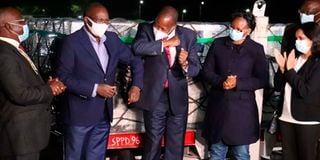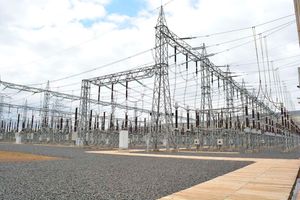Covid-19 war: Kagwe hails arrival of ‘heavy artillery’

Health Cabinet Secretary Mutahi Kagwe (centre), Transport CS James Macharia and Health PS Susan Mochache at the Jomo Kenyatta International Airport in Nairobi on March 2, 2021 after receiving Covid-19 vaccines.
What you need to know:
- Arrival of first batch of Covid-19 vaccines provides relief for Kenyans after a year of living in fear of death.
- Health ministry said it would start inoculating frontline workers — medics, teachers and the police— from tomorrow.
After a year of death, despair and constant fear of contracting Covid-19, Kenya yesterday opened a new frontier in its fight against the deadly disease.
The country received its first batch of vaccines that Health Cabinet Secretary Mutahi Kagwe likened to heavy artillery in the war against a pandemic that has claimed more than 1,860 lives.
“Overall, things are definitely getting better. It’s truly a great day for Kenya. We now have the equivalent of a bazooka or a machine gun in our fight against the virus,” Mr Kagwe said when he received the 1.02 million doses of the AstraZeneca jabs at Jomo Kenyatta International Airport in Nairobi early yesterday.
With the one million shots of the vaccine from the Serum Institute of India (SII), the Health ministry said it would start inoculating frontline workers—medics, teachers and the police— from tomorrow.
The Pharmacy and Poisons Board (PPB) last week approved the AstraZeneca vaccine for emergency use and more than 400,000 health workers will receive the jabs from Friday, Mr Kagwe said.
The 1.02 million doses are enough for slightly over 500,000 people requiring two doses eight to 12 weeks apart, meaning that the country’s entire health staff can be inoculated using the first batch.
Combating virus
With vaccines being the safest and most effective way to combat the virus, the vaccination is an assurance to the frontline workers that they are a bit safe even as experts and the ministry emphasize on continued compliance with other safety protocols—maintaining social distance, washing hands and wearing face masks.
“In as much we have the vaccine here with us, not everybody is going to be vaccinated in the first phase, and anybody who thinks we can begin to let our guard down better think again,” Mr Kagwe said, in an apparent reference to the positivity rate that is nearing 10 percent, a dangerous zone.
It is not yet known how long protection lasts with any of the vaccines but a study found unvaccinated people are protected after catching Covid-19 for at least six months.
Once the three cadres of frontline workers are vaccinated, it will mean transmission of the virus in schools, hospitals and correctional facilities will be reduced.
Immediately after phase I, the government will have started procurement of the second batch of the vaccine for the second phase which will run between July this year to June 2022 targeting 9.76 million of the most vulnerable people, the elderly and those above 18 years with underlying conditions.
The third phase will focus on ensuring equitable vaccination of other vulnerable groups of 18 years and above in congregations, and the hospitality and tourism industry. The phase will run between July 2022 and June 2023 targeting 4.9 million people.
Viral load
“There are plans to increase coverage to 40 percent of the population (20 million) once more supplies become available,” the national Covid-19 vaccines deployment and vaccination plan reads in part.
With a target of vaccinating at least 16 million people or 30 percent of the population in the next three years at Sh34 billion, Kenya will be on its way to stop community transmission and reduce its viral load.
According to vaccine experts, the AstraZeneca vaccine allows more people to be protected faster.
The doses, according to scientific reports, are easy to store and distribute due to their positive temperature of between two and eight degrees Celsius. The vaccine will be administered in levels four, five, and six hospitals estimated at five percent of the total facilities—approximately 479, 284 public and 195 private.
The head of vaccines and immunisation at the Health ministry, Mr Collins Tabu, explained that the jabs that landed yesterday were transported in special insulated boxes capable of maintaining the temperature of the doses to viable levels.
“Each of these pallets contains 3,000 doses which further has six smaller pallets with 500 doses. The pallets are lined with ice to maintain the cold chain,” said Dr Tabu.
Vaccination centres
The jabs have since been moved to the central vaccine depot in Kitengela from where they will be distributed to eight other depots and vaccination centres across the country. And, in two days, the vaccines will be cleared for transportation to different regional depots for distribution to health facilities.
“Our logistics team has acquired thermal blankets that will be used to maintain the temperatures of the vaccines as they are moved from the cargo plane and loaded onto the trucks that have also been fitted with a cold storage system,” Dr Willis Akhwale, the chair of the vaccine advisory task force, told Nation.
Some counties will pick the vaccines from the nearest regional depots while others like Kisumu, Mombasa and Kilifi will have the vaccines delivered to them by air freight.
The regional depots are located in Mombasa (Kilifi, Kwale, Lamu, Mombasa, Taita Taveta and Tana River); Eldoret (Baringo, Elgeyo -Marakwet, Nandi, Trans Nzoia, Turkana, Uasin Gishu and West Pokot); Kakamega (Bungoma, Busia, Kakamega and Vihiga) and Meru (Isiolo, Marsabit, Meru, and Tharaka Nithi)
Others are in Kisumu (Homabay, Migori, Kisumu, Nyamira and Siaya); Nyeri (Embu , Kirinyaga , Laikipia and Nyeri); Garissa (Wajir, Mandera and Garissa); Nakuru (Bomet, Kericho , Nakuru, Nyandarua and Samburu) and Nairobi (Kajiado, Kiambu, Kitui, Machakos, Makueni, Murang'a, Nairobi and Narok ).






